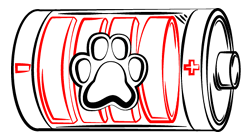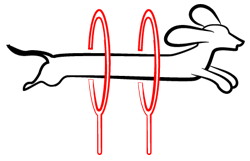
Paws ‘N’ Pups Quickview
Size
| Energy Level
| Trainability
| Paws ‘N’ Pups Rank
|
Characteristics
| Physical Characteristics: Height: 21-23” Weight: 50-70 lbs. Energy Level: High | Colors: The Alaskan Malador is found in the following colors:
|
Health & Longevity
Average Life Span: 10-15 years
The Alaskan Malador, a cross between a Labrador Retriever and an Alaskan Malamute, are known for being healthy and rambunctious, especially as puppies. Their origin breeds are also notable for being healthy dogs overall, but there are a few health hazards to be concerned with as your hybrid pup gets older.
Joint Dysplasia – Also known as canine arthritis, this condition affects mostly large-breed dogs because their size inevitably takes a toll on their joints. You might notice that your Alaskan Malador has a difficult time doing simple things, like squatting to use the bathroom, or jumping up on the couch. Their elbow joints might begin to look swollen and irritated. Luckily, regular trips to the vet can catch this condition before it worsens. Canine medications for inflammation and pain can help manage painful symptoms.
Entropion – Prominent in Labradors, this is a genetic eye condition where the eyelid folds inwards. Inversion can cause scratches on the cornea or skin infections from bacteria getting trapped between the lid folds. In the best cases, your vet will prescribe ointment lubricators and artificial tears to moisten the eye and encourage the lid to fold back into a normal position. In the worst cases, the condition requires surgery to correct.
Alaskan Maladors have a reputation for being resilient to most diseases and conditions that commonly affect big dogs. Thanks to their parent breeds, these crossbreeds have good genes for a long, healthy life. With regular veterinary visits and good healthcare, your pup could live between 10-15 years.
Temperament & Train-ability
Devoted, loyal, and friendly, the Alaskan Malador is a great family companion and protector for kids. These crossbreeds quickly imprint and bond with the members of their family, dedicating themselves to the protection and happiness of their loved ones. Alaskan Maladors would prefer to be with their humans at all times, which means they do not make for good outside dogs or day-crated canines. Left to their own devices, these pups can become bored quickly, and that leads to the destruction of their surroundings. Keep them well-entertained with chew toys and your company.
While wary of strangers, these pups rarely bite, choosing to remain docile and laid back. However, if they feel that their loved ones are being threatened, the Alaskan Malador will let out a rumbling growl to warn the perceived threat. If strangers are friendly and approach with non-threatening movements, these pups are more than happy to receive tummy rubs and plenty of affection.
Alaskan Maladors require a lot of time and patience to train. Where the Labrador genes in them are happy to do as you instruct, the Malamute side is fiercely independent and stubborn. Perseverance is key to dealing with the training difficulties of this crossbreed. Be determined and consistent by using a rewards system. Establish dominance as the pack leader with clear, concise, repeated commands. Let your Alaskan Malador know that you, as the Alpha, expect follow-through on those commands.
Rambunctious, active, and energetic, Alaskan Maladors require your commitment to their fitness and happiness. They need physical playtime and stimulation to keep their intelligent, ever-roaming mind busy. Fenced-in backyards are a very good idea, but be careful, as these dogs are keen diggers. Walk your pup at least twice a day and have interactive playtime to ensure his destructive boredom remains in check.
Grooming
The Alaskan Malador has a short, fine coat that regularly sheds, so daily brushing is necessary to eliminate excess hair. These pups love the water outside but are prone to fits in an enclosed space, like a bathtub. If bathtubs are your only option, ease your Malador into the bath as a puppy to get him used to bathing there.
Always use a for-dogs shampoo since human shampoo can break out your pup’s skin beneath his coat. Puppy conditioner isn’t necessary, but it does help to keep the coat softer and shinier.
Since Alaskan Maladors love to run, roll, and play regularly, they collect nasty stuff in their ears and under their nails. Make sure you keep their nails trimmed, at least once a month, to avoid infections. You should also clean their ears once a week to banish any built-up outdoor gunk.
Diet
Unfortunately, Alaskan Maladors are prone to overeating and becoming overweight, which can perpetuate joint issues later in life. To keep your pup healthy and fit, divide 3-4 cups of dry kibble into two meals per day.
Quality counts for big dogs, so snag a bag of nutritious food with high protein and fiber and be sure to avoid those with chemicals, by-products, and preservatives. Meat should ideally be at the top of the ingredients list. When your Malador wants a treat, offer him ground meats or organic, wholesome snacks from your local pet store. Most treats are loaded with unhealthy fillers, so check the labels before you make a selection.
Looking for an Alaskan Malador?
 Find An Alaskan Malador Breeder |  Alaskan Malador Puppies For Sale |  Adopt An Alaskan Malador |
Cost
Because Alaskan Maladors are rare crossbreeds between a Labrador and an Alaskan Malamute, you can check with shelters first. Adoption fees run the gamut of $250 to $300, excluding vet visits and food expenses. If you were to get an Alaskan Malador from a breeder, you can expect to pay $550 to $650 for a puppy, or $450 to $500 for an adult.
Paws ‘N’ Pups Ranking
Paws ‘N’ Pups ranks every breed out of 4 with 1 being easiest to integrate into your life and 4 being the toughest – The lower the ranking the better.
Ranking takes into account a few basic factors including cost, skill level needed, high vs low maintenance and how critical regular training is to success. Alaskan Maladors are moderately easy to integrate into your life. How easy they are to train and their overall needs depend on how old they are when you adopt them into your family.
If you invest in a Malador puppy, they are easier to integrate into your family because they are learning all of their habits from you. If you invest in an adult crossbreed, they might be harder to integrate because they lived elsewhere under different circumstances before joining your family.
Overall, the Alaskan Malador would get a solid 2.5 with a balance of stubbornness, friendliness, great health, and general expense.
Breeds Similar To Alaskan Malador
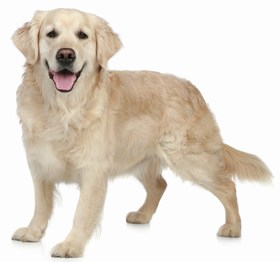 Labrador Retriever | 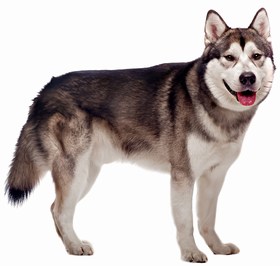 Alaskan Malamute |  Golden Retriever | 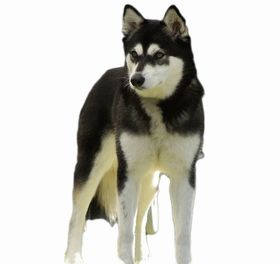 Alaskan Klee Kai |


